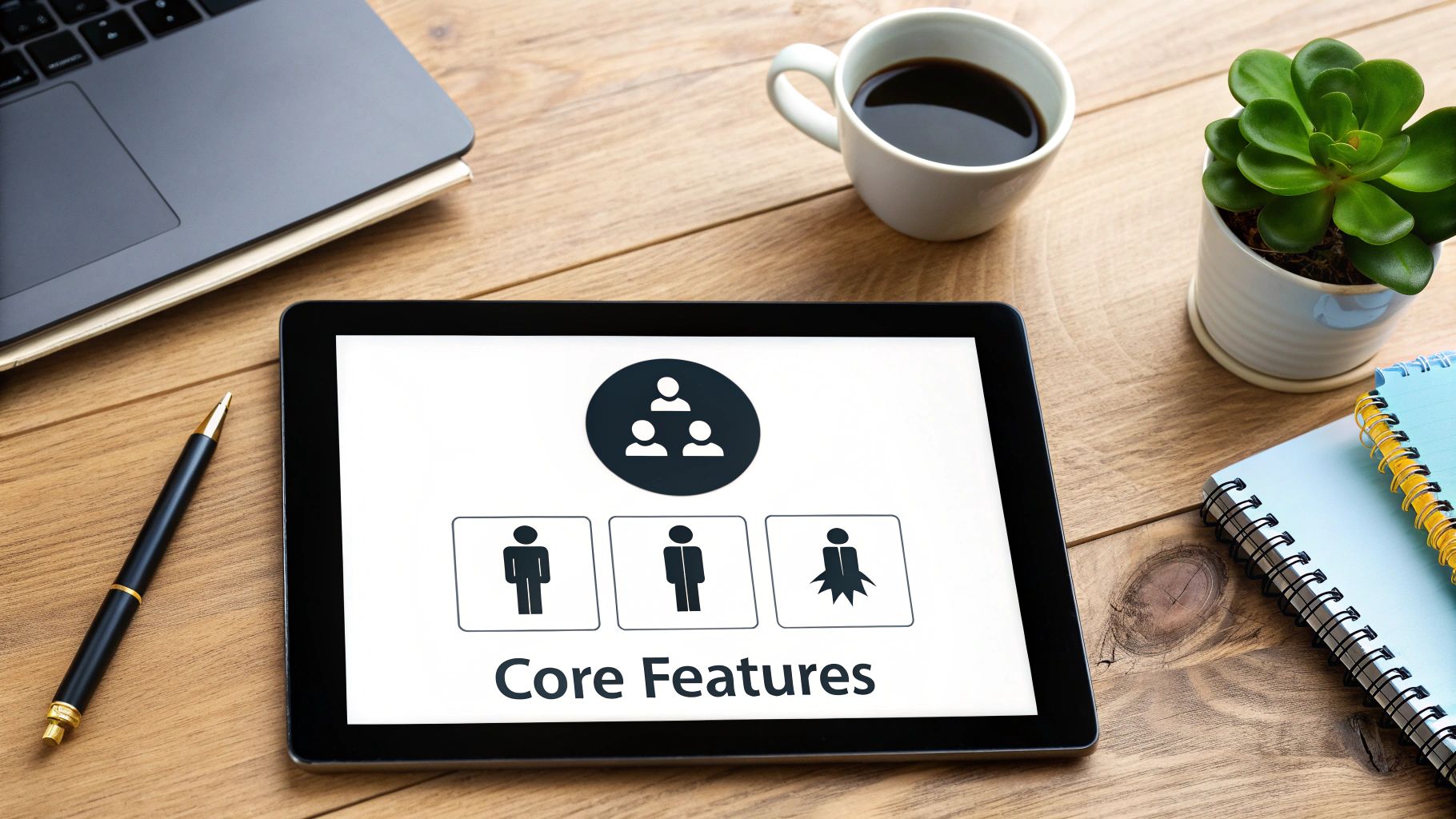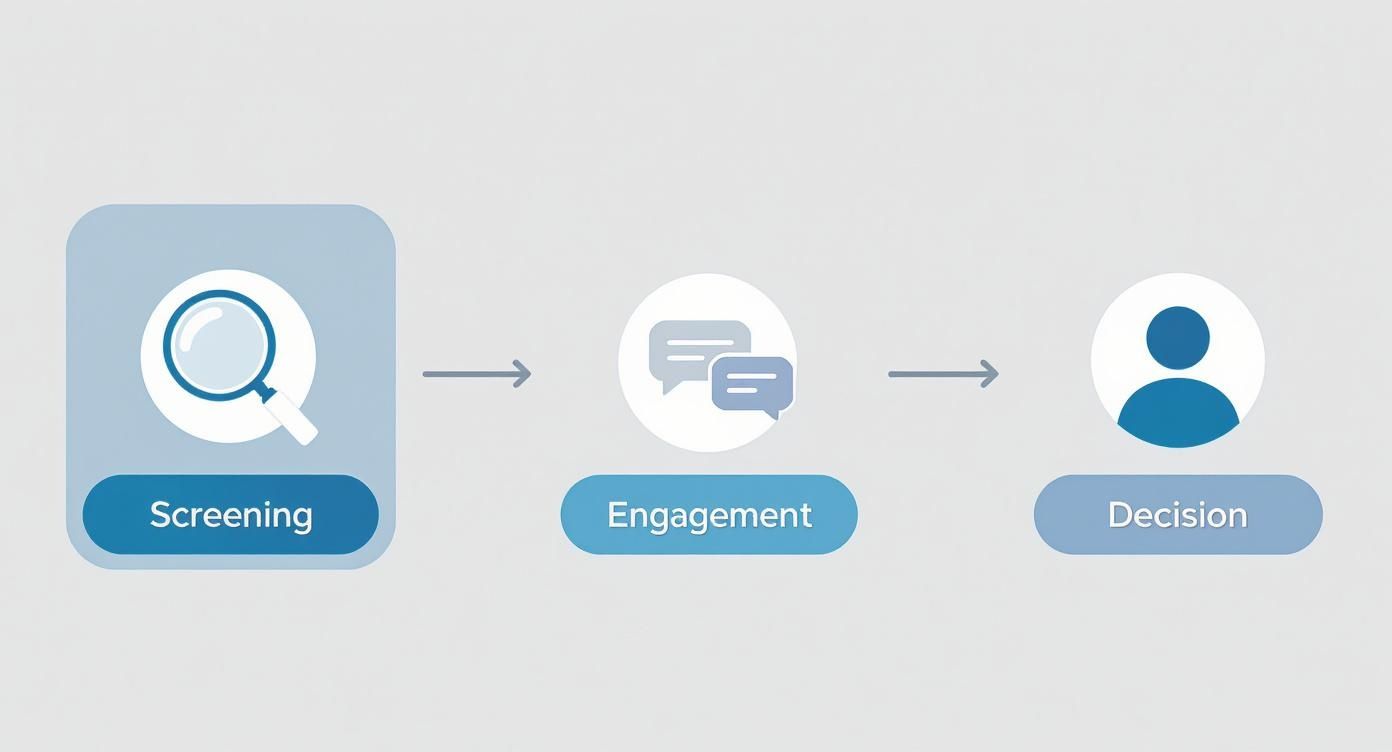So, what exactly is a hiring management system? Think of it less as a piece of software and more as a dedicated command centre for your entire recruitment operation. It’s the one central hub that replaces the tangled web of messy spreadsheets, overflowing email inboxes, and scattered sticky notes with a single, intelligent solution.
Your Recruitment Command Centre

Have you ever tried to direct a symphony orchestra where every musician is playing from a different sheet of music? The result would be absolute chaos. Honestly, that’s what manual hiring often feels like—disjointed, wildly inefficient, and full of opportunities for mistakes. Recruiters are constantly switching between different tools, candidate details get lost in the shuffle, and trying to get hiring managers on the same page becomes a frustrating game of broken telephone.
A hiring management system steps in as the conductor, bringing a much-needed sense of harmony and structure to the whole performance. It creates a single source of truth, making sure everyone involved—from the talent acquisition team to department heads—is working from the same script. This is a game-changer. It transforms recruitment from a reactive, administrative headache into a strategic, data-driven part of the business.
From Chaos to Cohesion
Without a proper system, the typical hiring process is completely fragmented. A new job request might start in an email chain, resumes are piling up in a shared folder, interview feedback is tracked (or not tracked) in a spreadsheet, and conversations are happening all over the place. This isn’t just slow; it’s risky. Crucial details fall through the cracks, you end up delivering a poor candidate experience, and you might even miss out on the best person for the job.
The entire point of a hiring management system is to eliminate that fragmentation. It does this by centralising all your key activities and automating the repetitive, time-consuming tasks that bog recruiters down.
- Unified Communication: Every single interaction with a candidate, from the first message to scheduling the final interview, is logged in one clean, easy-to-access profile.
- Automated Workflows: The system can handle the grunt work, like automatically screening CVs for keywords, sending out polite rejection emails, or moving qualified candidates to the next stage.
- Data-Driven Insights: It gives you real analytics on critical metrics like time-to-hire and cost-per-hire, so you can actually see what’s working and what needs to be fixed.
By bringing every single part of the recruitment lifecycle into one cohesive platform, a hiring management system frees up your team to focus on what really moves the needle: finding and engaging top-tier talent.
At its core, this technology provides the framework you need to build a hiring engine that is repeatable, scalable, and genuinely efficient. It ensures consistency, strengthens your employer brand through better communication, and gives your team the tools to make smarter, faster decisions. In today’s battle for talent, that foundation is everything.
Exploring the Core Features of Modern Hiring Platforms

A modern hiring management system is so much more than a digital filing cabinet for CVs. Think of it as an active ecosystem of tools, with each one designed to solve a specific challenge you face on the talent acquisition journey. When you understand these core features, it becomes crystal clear why these platforms are indispensable for today’s recruitment leaders.
These components all work together to automate the repetitive tasks, give you the data you actually need, and free up your team to focus on the human side of hiring. It’s like a well-equipped workshop where every tool has a precise function, allowing you to build a powerful and efficient hiring engine.
Let’s break down the essential features that make it all happen.
Automated Applicant Tracking
At the very heart of any hiring platform is the Applicant Tracking System, or ATS. Its main job is to bring order to the chaos of incoming applications. Instead of your team manually sifting through hundreds of emails and attachments, the ATS pulls every candidate profile into a single, searchable, and organised database.
But this isn’t just about storage; it’s about action. The system automatically reads CVs, pulling out key information like skills, experience, and contact details. This lets your recruiters instantly filter for the right candidates, track their progress through your unique hiring stages, and make sure no promising talent falls through the cracks.
Proactive Candidate Sourcing
Great talent doesn’t always come knocking on your door. Sometimes, you have to go out and find it. Modern systems come packed with powerful sourcing tools that help you build a proactive talent pipeline instead of just reacting to whoever applies.
These features often integrate with professional networks and job boards, letting recruiters search for passive candidates—those folks who aren’t actively job hunting but might be the perfect fit. By building and nurturing these talent pools within the system’s Candidate Relationship Management (CRM) module, you create a ready supply of qualified people for future openings.
Intelligent Interview Scheduling
Trying to coordinate interviews between a candidate and multiple people on your team can quickly turn into a logistical nightmare of back-and-forth emails. A hiring management system solves this headache with automated scheduling tools.
These features sync up with everyone’s calendars, allowing candidates to pick an available time slot that works for them. The system then sends out automatic confirmations and reminders, slashing administrative work and preventing scheduling conflicts. This simple function also massively improves the candidate experience, making the whole process feel smooth and professional.
A truly effective hiring platform moves beyond basic tracking to actively streamline every interaction. By automating scheduling and centralising communication, it frees up countless hours for recruiters to focus on what matters most—evaluating and engaging with top candidates.
Reporting and People Analytics
What you can’t measure, you can’t improve. This is where reporting and analytics come in, turning recruitment from a gut-feel exercise into a data-driven strategy. A quality hiring management system gives you real-time dashboards with the key performance indicators that matter.
You get immediate visibility into critical metrics like:
- Time-to-Fill: How long does it actually take to fill a position, from posting the job to getting an offer accepted?
- Source of Hire: Which channels are really delivering your best candidates? Is it LinkedIn, a job board, or referrals?
- Cost-per-Hire: What’s the total investment required to bring a new employee on board?
This data allows you to spot bottlenecks, put your recruitment budget where it counts, and make a solid business case for your strategies. Understanding these metrics is vital, and you can learn more about how a well-structured recruitment platform eases digital hiring in our detailed guide.
Essential vs Advanced Features in a Hiring Management System
Not all hiring platforms are created equal. While some offer foundational tools to get the job done, others provide advanced capabilities designed for more strategic talent acquisition. Understanding the difference helps you choose a system that not only meets your current needs but can also grow with your organisation.
Here’s a look at the must-haves versus the strategic advantages.
| Feature Category | Essential Functionality (Must-Have) | Advanced Capability (Strategic Advantage) |
|---|---|---|
| Applicant Tracking | Centralised candidate database, CV parsing, and pipeline stage tracking. | AI-powered candidate matching, predictive scoring, and automated shortlisting. |
| Candidate Sourcing | Basic job board integrations and manual search functions. | Proactive talent pool building, CRM for passive candidates, and social media sourcing tools. |
| Interview & Scheduling | Manual or semi-automated interview scheduling emails. | Automated self-scheduling links, calendar sync, and integrated video interviewing tools. |
| Analytics & Reporting | Standard reports on time-to-fill and source-of-hire. | Customisable dashboards, predictive analytics on hiring success, and DEI tracking. |
| Candidate Experience | Branded career pages and automated email templates. | Personalised communication workflows, candidate feedback surveys, and mobile-friendly applications. |
Choosing the right mix of features depends on your company’s size, hiring volume, and long-term goals. While the essentials cover the basics, the advanced capabilities are what truly empower a data-driven, strategic approach to building your team.
Ensuring Compliance and Governance
Finally, navigating the complex web of hiring regulations is a massive responsibility. A robust system helps you stay compliant by standardising your processes and keeping a clear audit trail of every action taken.
It can be configured to prompt for necessary documentation, track equal opportunity data, and ensure your hiring practices are fair and consistent across the entire organisation. This feature isn’t just a nice-to-have; it provides crucial peace of mind and protects your business from the potential legal risks that come with recruitment.
The Strategic Benefits for Your Organisation
Thinking of a hiring management system as just another tool to organise your workflow is missing the bigger picture. It’s really about turning recruitment from a simple cost centre into a powerhouse that drives your business forward. The real magic happens when you start seeing tangible results—better hires, a stronger employer brand, and a healthier bottom line.
Instead of crossing your fingers and relying on gut instinct, these systems arm you with the data you need to make genuinely smart hiring decisions. This isn’t just a fleeting trend; it’s a fundamental shift in how modern companies build teams that win. And that impact is felt in every corner of the business, starting with the very people you welcome through the door.
Elevate Your Quality of Hire
At the end of the day, the number one goal is to hire the right person. Not just someone who ticks the boxes on paper, but an individual who will truly thrive and contribute to your company’s long-term success. A hiring management system is your secret weapon here, using analytics to pinpoint the common traits of your existing top performers.
By digging into the data of past successful hires, the system helps you build a crystal-clear profile of what an ideal candidate actually looks like for your unique culture and needs. This means you can stop casting a wide, hopeful net and start focusing your energy on candidates who share those critical skills and attributes, massively boosting your chances of making a great hire.
This smarter approach also has a direct impact on employee turnover. When you consistently bring people on board who are a better fit from day one, they’re far more likely to be engaged, productive, and committed to growing with you.
Enhance the Candidate Experience
In today’s fierce talent market, the application process is often the first real interaction a candidate has with your brand. A clunky, slow, or confusing experience can scare off your dream hire before you’ve even had a chance to say hello.
A hiring management system helps you roll out the red carpet, creating a smooth, professional, and transparent journey for every single applicant.
- Effortless Applications: Mobile-friendly forms mean candidates can apply easily from their phone or any other device.
- Constant Communication: Automated updates keep applicants in the loop on their status, so they never feel like their CV has vanished into a black hole.
- Simple Scheduling: Integrated calendars let candidates book their own interview slots, cutting out the frustrating email tennis.
This kind of positive experience doesn’t just help you land top talent; it builds a stellar reputation in the market. Even candidates who don’t get the job walk away with a good feeling about your company.
Drive Clear Return on Investment
Let’s be honest: any business investment has to pay for itself. A hiring management system does this by delivering serious cost savings and efficiency boosts that you can see on your balance sheet. The most immediate win is a dramatic drop in your time-to-hire.
By automating tedious tasks like sifting through CVs and coordinating interviews, the system frees up your recruiters to focus on what they do best—building relationships with great candidates. This speed means critical roles get filled faster, slashing the productivity loss that comes with an empty seat. For a deeper dive into this, our guide on digital RPO for high-impact hiring and its strategies is a great resource.
By shrinking the hiring cycle, you not only get talent in the door faster but also lower your overall recruitment costs, including expenses related to job board advertising and agency fees.
It’s no surprise that the adoption of these platforms is exploding. The recruitment software market in India is expected to balloon to USD 120 million by 2033, up from USD 80 million in 2024. That’s a compound annual growth rate (CAGR) of 4.9%. This surge is fuelled by the widespread move to AI-powered digital hiring solutions that simplify key recruitment steps. You can read more about the growth of the Indian recruitment software market on imarcgroup.com. This proves that companies are waking up to the undeniable financial and strategic perks of investing in a modern hiring management system.
How AI Is Transforming Modern Recruitment
Artificial Intelligence isn’t some far-off concept from a sci-fi movie anymore; it’s a very real and powerful force that’s completely reshaping the modern hiring management system. Think of it as a super-intelligent assistant, one that takes on the high-volume, repetitive work so your recruitment team can get back to the human side of hiring – building relationships and making those crucial, nuanced decisions.
The idea isn’t to replace recruiters, but to amplify their skills. AI does the heavy lifting, like sorting through thousands of CVs with a speed and accuracy that’s simply not humanly possible. This frees up your talent acquisition experts to jump in at the most critical moments, armed with better data and more time.
Ultimately, bringing AI into the mix creates a smarter, more efficient, and data-backed hiring process from beginning to end.
Smarter Screening and Candidate Matching
Screening CVs used to be a tedious keyword-matching game. AI blows that old method out of the water. Using sophisticated algorithms, it reads and understands the entire application—looking at context, inferring skills, and even gauging a candidate’s potential to grow.
This means the system can spot a high-potential software developer who might not have the exact programming language from your job description but has solid experience with very similar technologies. It’s a deeper level of analysis that uncovers the hidden gems you might have otherwise missed.
AI-powered screening is about seeing the whole picture, not just isolated keywords. It helps you find candidates who are a true fit based on skills, experience, and cultural alignment, dramatically improving the quality of your shortlist.
Enhancing Candidate Engagement with AI
One of the biggest headaches in recruitment is the “black hole” experience for candidates. AI-powered chatbots, now a common feature in any modern hiring management system, are changing that by acting as a 24/7 point of contact for applicants.
These bots can instantly answer common questions about the role, company culture, or where an application stands. They can even handle the first round of basic screening questions. This kind of immediate response creates a much more positive experience and saves your recruiters from answering the same questions over and over.
The image below shows just how central AI and automation are becoming to hiring trends in India, which reflects a much larger global shift.
This visual drives the point home: 68% of recruiters are now using automation. It’s a clear sign that AI-driven tools are no longer a novelty but a standard part of the toolkit for efficient hiring.
This isn’t a one-way street, either. Candidates are embracing AI, too. In a sign of just how much things have changed, around 93% of Indian hiring managers are now comfortable with candidates using generative AI to polish their CVs and applications. This mutual adoption of AI is leading to more precise matches and a more efficient hiring cycle for everyone. You can find more insights on the Indian recruitment software market and AI adoption on imarcgroup.com.
This widespread acceptance points to a major evolution in how we recruit. Technology is now seen as a legitimate tool for both employers and job seekers, making the entire hiring process smarter and more effective all around.
A Practical Guide to Successful Implementation
Choosing a powerful hiring management system is a big first step, but the real win is in the execution. A smooth implementation is what turns a promising piece of software into a genuine strategic asset. If you rush this stage, you’ll likely end up with poor user adoption and a frustrating return on your investment.
A thoughtful rollout, on the other hand, makes sure your new system is embraced by the team and starts delivering value from day one. This requires a clear roadmap, starting with a deep dive into your own needs and ending with a well-trained, confident team.
Laying the Groundwork for Success
Before you even glance at a vendor’s website, you need to start with an internal audit. What are the biggest headaches in your current hiring process? Is it the painfully slow screening phase, messy interview scheduling, or a complete lack of meaningful data? Pinpointing these challenges is absolutely critical.
This initial needs assessment becomes the bedrock of your entire project. It lets you create a detailed list of “must-have” features versus “nice-to-have” extras. This ensures you pick a hiring management system that solves your actual problems, not just the ones a slick sales demo highlights.
- Stakeholder Buy-In: Get your recruiters, hiring managers, and IT folks involved from the very beginning. Their input is invaluable for spotting needs, and getting them on board early builds a sense of ownership.
- Build a Business Case: Use what you found in your audit to create a compelling argument. Focus on tangible results like a shorter time-to-hire, lower recruitment costs, and a better quality of hire.
Choosing the Right Partner and Planning the Rollout
Once your requirements are crystal clear, you can start looking at vendors. But look beyond the feature lists. You’re looking for a true partner—a provider who gets your industry and offers solid support and training. After you’ve made your choice, the detailed planning can begin.
This is where you map out the entire implementation journey, from migrating old data to tweaking the new system to fit your unique workflows. A phased approach is often the smartest move. Start with a pilot group before launching it company-wide. This lets you iron out any kinks in a controlled environment. For a more structured look at this, check out our guide on the 7 essential steps for digital hiring using recruitment technology.
A successful implementation isn’t just a technical project; it’s a change management initiative. Your goal is to guide your team through a transition, demonstrating how the new system makes their jobs easier and more effective, not just different.
This forward-thinking approach is especially vital in today’s job market. For instance, the hiring landscape in India is gearing up for major growth, with a staggering 72% of employers planning to expand their teams in the latter half of 2025. This surge in new roles makes efficient, scalable hiring tools more important than ever. You can learn more about India’s optimistic hiring outlook from The Times of India.
Championing Adoption Through Training and Support
The final—and most critical—phase is user training. Even the best hiring management system will flop if your team doesn’t know how to use it properly or, worse, doesn’t want to. Your training needs to be hands-on, role-specific, and really sell the “why” behind the change.
Show recruiters how automation will free them from boring administrative tasks. Show hiring managers how they can get a much clearer view of the candidate pipeline.
The infographic below gives a great overview of the core stages modern systems manage, from the initial screening right through to the final decision.

This visual helps to show how a well-implemented system organises the entire recruitment funnel into a logical and efficient flow. But the work doesn’t stop at launch. Ongoing support is just as important. Appoint internal champions, create easy-to-find resources, and make sure to celebrate early wins. This builds momentum and ensures the new system becomes an indispensable part of how you find and hire great talent.









